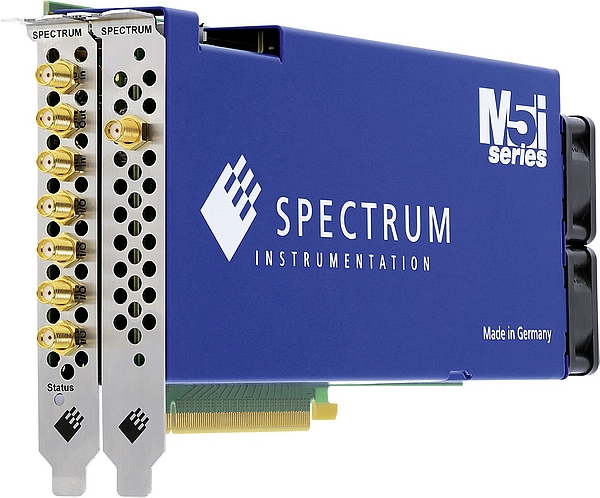- The new M5i.3350-x16 and M5i.3357-x16 digitizers feature one and two acquisition lanes respectively.
- They offer sampling capabilities at a rate of 10 GS/s on one chanel (5 GS/s on two chanels), 12-bit vertical resolution, and 12.8 GB/s data streaming capability over the 16-lane PCIe Gen3 bus.
- The streaming function allows acquired data to be transmitted directly to the PC memory for storage, or to CPUs and GPUs for specific signal processing and analysis.
- The cards also feature front-end circuitry with 3 GHz bandwidth and up to 16 GB (8 GSamples) of on-board memory.
With 12-bit resolution, these digitizers deliver 16 times more resolution than many digital oscilloscopes, which typically use 8-bit analogue to digital converters. The extra resolution allows measurements to be made with better signal to noise ratio (SNR), and improved accuracy and precision. It also lets users capture and characterize fine signal details that are often missed by lower resolution devices.
The front-end circuitry has over 3 GHz bandwidth, with programmable full-scale ranges from ±200 mV to ±2.5 V together with variable offset. Acquisitions can be made in single-shot or multiple-waveform recording modes. Multiple recording divides the on-board memory into segments and allows the acquisition of numerous events, even at very high trigger rates. For added flexibility, the on-board memory can be used as a ring-buffer, working much like a conventional oscilloscope, or as a FIFO-buffer for the continuous streaming of data to the PC environment.
To help capture the most elusive signals, a host of trigger modes are available for use on the channel or external trigger inputs. The modes include conventional edge triggering, along with more sophisticated methods such as Window, Re-Arm, Or/And (logical), Software and Delay. Triggering is fast and accurate with waveform data being stored together with its relevant trigger time stamp information. SMA connectors are available on the front panel for the channel inputs, clock and trigger inputs and outputs, as well as four multi-functional digital I/O lines. The extra clock and trigger connections make it possible to synchronize the card with additional digitizers or other measurement devices.
The cards can turn almost any PC it into a measurement tool just by installing them in a suitable PCIe slot. This also opens the door for anyone wishing to use the latest CPU and GPU hardware for signal processing and analysis. The cards come with all the tools necessary to use them in a PC running either a Windows or Linux operating system. A software development kit (SDK) is provided so that the cards can be programmed with almost any popular language. This includes C, C++, C#, Delphi, VB.NET, J#, Python, Julia, Java, LabVIEW, and MATLAB. The SDK contains all the required driver libraries as well as programming examples. Alternatively, for users who do not want to write their own code, the German company offers SBench 6 Professional. This measurement software provides full card control, along with a host of data display, analysis, storage, and documentation capabilities.
A key differentiator for all the Spectrum Instrumentation PCIe cards is their capability to stream data directly to and from a CUDA GPU. This is made possible by the company’s SCAPP package (Spectrum’s CUDA Access for Parallel Processing), which is available as an option. SCAPP includes the drivers for CUDA GPU support and allows users to develop their own processing routines. To help getting started, the package includes working examples that can be modified and built upon. It is ideal for users who need to perform data intensive processing, like continuous averaging for noise reduction, or MPoint-FFTs for spectral analysis.
Another option that is available for the new cards is on-board summation averaging (option M5i.33xx-spavg). Averaging is a useful tool for reducing unwanted signal noise. At the same time, it can improve measurement resolution beyond the digitizers standard 12-bit performance, delivering more dynamic range and better SNR. The option uses the cards on-board FPGA (Field Programmable Gate Array) technology to average waveforms, even when they are sampled at the full 10 GS/s. The result is a signal averaging solutions capable of averaging at a rate of up to 15 million events per second due to the short dead-time of less than 40 ns between events.






